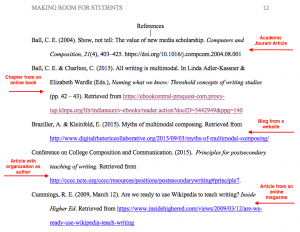APA Citations: References
The remainder of this section provides basic information pertaining to creating the Reference page. Information about formatting your paper and/or incorporating APA headings can be found at the OWL of Purdue.
Reference Page Entries
- Every source that you quote, paraphrase, or summarize in an essay must be included in your Reference page
- The Reference page should appear on its own page. It should include the header (i.e. abbreviated title with the page number in the righthand corner) without the words “Running head.”
- At the start of your list, at the top margin of the page, center the word “References.” Do not bold, italicize, or use quotations marks. Do not change the font, font size, or color
- Reference page entries are in the same font and double spacing as the rest of the paper
- Like MLA, Reference page entries use hanging (also known as reverse) indentation, in which the first line of an entry is not indented, but all successive lines are indented, by .5”.
- Sources need to be listed in alphabetical order by the first letter in each entry.
-
- If you have a source with no author, then that source will be alphabetized according to the first letter of its title
- The entries will not be numbered or presented as a series of bulleted points.
Examples of Reference Page Entries
Formatting an Article from an Academic Journal with DOI
Author’s last name, first initial. middle initial. (Year, Month Date Published). Title of the article. Title of the Academic Journal, Volume # (Issue #), page numbers, DOI.
Example of an Article from an Academic Journal with DOI
Werner, C. L. (2015). Speaking of composing (frameworks): New media discussions, 2000-2010. Computers and Composition, 37, 55-72. doi:http://dx.doi.org/10.1016/j.compcom.2015/06.005
Formatting an Article from an Academic Journal with no DOI
Author’s last name, first initial. middle initial. (Year, Month Date Published). Title of the article. Title of the Academic Journal, Volume # (Issue #), page numbers, Retrieved from URL.
Example of an Article from an Academic Journal with no DOI
Yancey, K. B. (2004). Made not only in words: Composition in a new key. College Composition and Communication, 56(2), 297-328. Retrieved from http://www.jstor.org/stable/4140651
Formatting an Article from an online magazine
Author, A. A., & Author, B. B. (Date of publication). Title of article. Title of Online Periodical, volume number(issue number if available). Retrieved from
https://www.someaddress.com/full/url/
Example of an Article from an online magazine
Wong, A. (2015, April). Digital natives, yet strangers to the web. The Atlantic. Retrieved from https://www.theatlantic.com/education/archive/2015/04/digital-natives-yet-strangers-to-the-web/390990/
Formatting an Article from a Website with an Author
Last, F. M. (Year, Month Date Published). Article title. Retrieved from URL.
Example of an Article from a Website with an Author
Braziller, A. & Kleinfeld, E. (2015). Myths of multimodal composing. Retrieved from http://www.digitalrhetoriccollaborative.org/2015/09/03/myths-of-multimodal-composing/
Example with an Organization as Author
National Council of Teachers of English. (2005, November). Position statement on multimodal literacies. Retrieved from http://www.ncte.org/positions/statements/multimodalliteracies
Formatting an Article from a Website with No Author
Title. (Year, Month Date Published). Retrieved from URL.
Example of an Article from a Website with No Author
Mobile campus laptop loan program (2019). Retrieved from https://www.csuohio.edu/services-for-students/mobile-campus
What is the DOI?
DOI stands for “digital object identifier” and it helps categorize scholarly articles. However, not all scholarly articles will have a DOI. If that is the case, then you should provide the URL where you retrieved the article.
Sample Reference Page


